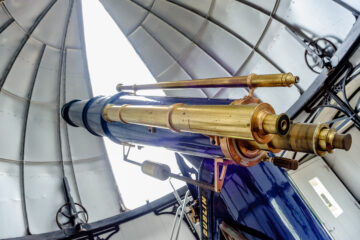COOLEST DECEMBER FOR SIX YEARS, SLIGHTLY SUNNIER AND WETTER THAN AVERAGE. CALENDAR YEAR 2020 WARMER AND SLIGHTLY WETTER AND SUNNIER THAN AVERAGE.
Armagh Observatory reports that December 2020 was cooler than average at Armagh, the coolest December for six years, and slightly sunnier and wetter than average. Calendar year 2020 was warmer than average and slightly wetter and sunnier.
The mean monthly temperature was 4.8 C (40.6 F), which is approximately 0.2 C warmer than the long-term (1796-2010) December average at Armagh but 0.1 C cooler than the most recent (1981-2010) 30-year average.
The highest maximum air temperature was 11.7 C, which occurred shortly after midnight on the night of the 17th/18th December and again shortly after midday on the 18th. The lowest maximum air temperature was 3.5 C on the 3rd, followed by 4.0 C shortly after midnight of the night of the 27th/28th. The highest minimum air temperature was 7.2 C on the morning of the 14th, followed by 6.8 C which occurred during early afternoon of the 10th. The lowest minimum air temperature was -2.7 C recorded on the morning of the 6th followed by -2.6 C on the 7th.
There were 25 ground frosts, the sharpest of which were -13.1 C recorded on the 30th and -12.4 C on the 29th. There were six nights with minimum air temperatures less than or equal to zero. Christmas Day was cooler than average with an average temperature of 4.2 C.
Total December precipitation was 80.25 mm (3.16 inches) including 5 trace values, or 80.0 mm if trace values are ignored. This is nearly 4% more than the average December rainfall at Armagh, making this December slightly wetter than average. The wettest day was the 26th with 14.4 mm (0.57 inches) of rainfall associated with Storm Bella, followed by the 15th with 10.1 mm (0.40 inches). Sleet and snow were recorded on the 27th, with snow overnight on the 30th/31st leading to a light covering of snow on the 31st.
With a total of 42.4 hours of strong sunshine, December 2020 was slightly sunnier than average with approximately 12% more strong sunshine than the long-term (1881-2010) December average at Armagh and nearly 5% more than the most recent (1981-2010) 30-year average. The sunniest day was the 20th with 5.3 hours of strong sunshine, followed by the 12th with 4.9 hours.
Considering the year as a whole, calendar year 2020 at Armagh was warmer (average temperature 10.23 C), slightly wetter (total rainfall 858.15 mm including 43 trace values) and slightly sunnier (1318.7 hours of strong sunshine) than average. However, the yearly average masks substantial month-to-month and seasonal variations, for example February 2020 was very wet, leading to winter 2019/2020 being rather wetter than average, while March was relatively dry and April and May both very dry. This led to a record-breaking spring, the sunniest spring on record at Armagh (that is, for at least 140 years) and the driest for 74 years, that is, since spring 1946. This was the sixth-driest spring at Armagh since daily rainfall records began at the Observatory in 1838.
The dry and exceptionally sunny spring was followed by June, July and August each duller and wetter than average. June and August were warmer than average, but July was relatively cool, the coolest July at Armagh for five years. June was also the dullest at Armagh for eight years and July the dullest for 34 years. Taking the three summer months together, summer 2020 was the coolest at Armagh since summer 2015, the wettest since 2012 and the dullest, that is, with the fewest hours of strong sunshine, since 1987. This was the third dullest summer at Armagh on record, that is, since daily sunshine records began at Armagh in April 1880. Taking the following months September, October and November together, the meteorological autumn was mild and slightly drier and sunnier than average.
The Observatory’s weather records also show that 2020 was rather warmer than average, the tenth-warmest calendar year on record at Armagh. Thirteen of the last 20 years have mean annual temperatures at Armagh greater than 10.0 C, a result that includes each of the last five years.
Considering the four most recent 30-year temperature averages, the 1961-1990 30-year mean annual temperature was 9.24 C whereas the 1991-2020 average was 9.94 C, an increase of 0.7 C in thirty years.
However, the increase in mean annual temperature at Armagh is not uniform throughout the year, but more strongly concentrated on the winter months January and February at the expense of June and July. In the same way, following a lengthy period of relatively dry Julys at Armagh, lasting from approximately 1955 to 2005, it appears that the average July rainfall may now be returning to the slightly wetter long-term mean.
These kinds of detail illustrate the complexity of assessing the significance of trends, or apparent trends, in Northern Ireland’s climate on human timescales, particularly given the wider context of regional and global climate change. This highlights the importance of maintaining long-term climate records such as those at Armagh Observatory.
The attached Figures show respectively the mean annual temperature recorded at Armagh from 1796 to 2020, the total annual precipitation from 1838 to 2020, and the annual number of hours of strong sunshine from 1881 to 2020. In broad terms they show significant year-to-year variability, a variety of multi-decadal oscillations, a general increasing trend in average temperature contrasting with a roughly constant level of annual precipitation, and an increase in strong sunshine reversing a longer term previous downward trend.
These data refer to observations at Armagh Observatory, which has been recording the weather at Armagh since 1795.






0 Comments